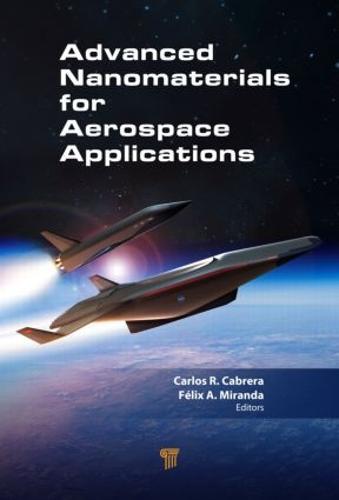Overview
Advanced Nanomaterials for Aerospace Applications has been developed for a community interested in space science and nanotechnology. Scientists and engineers from several NASA field centers and the Jet Propulsion Laboratory, University of Puerto Rico, The Pennsylvania State University, and INFN-Laboratori Nazionali di Frascati, Italy, have joined efforts to discuss the applications of nanomaterials in sensors, atmosphere revitalization in habitable space platforms, life support systems, regenerative fuel cells, lithium-ion batteries, robust lightweight materials, nanoelectronics, and electromagnetic shielding. The book concludes with chapters that discuss bringing NASA-relevant nanotechnology into the classroom and the future directions in nanotechnology research and development at NASA.
Full Product Details
Author: Carlos R. Cabrera , Felix Miranda
Publisher: Pan Stanford Publishing Pte Ltd
Imprint: Pan Stanford Publishing Pte Ltd
Dimensions:
Width: 15.20cm
, Height: 2.50cm
, Length: 22.90cm
Weight: 0.686kg
ISBN: 9789814463188
ISBN 10: 9814463183
Pages: 394
Publication Date: 15 July 2014
Audience:
College/higher education
,
Professional and scholarly
,
Tertiary & Higher Education
,
Professional & Vocational
Format: Hardback
Publisher's Status: Active
Availability: In Print 
This item will be ordered in for you from one of our suppliers. Upon receipt, we will promptly dispatch it out to you. For in store availability, please contact us.
Table of Contents
Advanced Sensor Nanomaterials for Aerospace Applications, Gary W. Hunter, Jennifer C. Xu, and Laura J. Evans Challenges and Possibilities in Nanosensor Technology, Gary W. Hunter, Laura Evans, Jennifer Xu, and Azlin Biaggi-Labiosa Nanoporous Materials in Atmosphere Revitalization, Arturo J. Hernández-Maldonado, Yasuyuki Ishikawa, Raphael G. Raptis, Bernadette Luna, Lila Mulloth, Christian Junaedi, and Subir Roychoudhury Nanomaterials for Advanced Lithium-ion Battery Anodes, Richard S. Baldwin, James J. Wu, and William R. Bennett Advances in Designing High Energy Cathode Materials for Li ion Rechargeable Batteries, Ram S. Katiyar, and Gurpreet SinghNanomaterials in Regenerative Fuel Cells, Thomas Valdes, Ileana González-González, and Carlos R. Cabrera Nano-Technology in Advanced Life Support: Water Recycling, Michael Flynn, Eduardo Nicolau, and Carlos R. Cabrera Nanotechnology for Nanoelectronic Devices, Félix A. Miranda and Harish M. Manohara Brief Introduction to Nanocomposites for Electromagnetic Shielding, S. Bellucci and F. Micciulla Epoxy Nanocomposite based on Carbon Nanotubes for Electromagnetic Interface (EMI) Shielding, S. Bellucci and F. MicciullaBringing NASA-relevant Nanotechnology Research into the Classroom, Ana-Rita Mayol, Christian Menéndez, Melissa Dávila, and Liz DíazFuture Directions in Nanotechnology R&D at NASA, Michael A. Meador
Reviews
The text is highly inspirational, easy to read and filled with data, knowhow and seemingly countless bright ideas. Much of the text lies within the grasp of undergraduates studying nano tech for the first time, also graduates and university tutors (particularly those preparing new courses). An excellent book containing 773 numbered references, there for the professional to explore. -Peter C. Gasson, CEng, MIMechE, FRAeS, in The Aeronautical Journal, June 2015
The text is highly inspirational, easy to read and filled with data, knowhow and seemingly countless bright ideas. Much of the text lies within the grasp of undergraduates studying nano tech for the first time, also graduates and university tutors (particularly those preparing new courses). An excellent book containing 773 numbered references, there for the professional to explore. -Peter C. Gasson, CEng, MIMechE, FRAeS, in The Aeronautical Journal, June 2015
Author Information
Dr. Carlos Cabrera is professor at the Department of Chemistry of the University of Puerto Rico, Río Piedras Campus. Cabrera’s main research area is on the development of nanocatalysts for clean energy technology such as fuel cell systems. This energy system is of importance for the development of environmentally friendly energy conversion and storage based on alcohols. Fuel cells are becoming a promising clean energy system for vehicles, portable devices, and power generators. This area of research is part of the research conducted at the Institute for Functional Nanomaterials (IFN). Through the institute, Cabrera will develop catalytic nanomaterials for fuel cell testbeds and prototypes that will be evaluated at the NASA Glenn Research Center in Cleveland, Ohio. This creation of the IFN is creating a unique opportunity for the further development of Cabrera’s nanotechnology research since new state-of-the-art instrumentations and unique partnerships will be established with nanotechnology centers located at Purdue University, University of Massachusetts, Northwestern University, Cornell University, and the Argonne National Laboratory. Dr. Félix A. Miranda received his B.S. degree in physics from the University of Puerto Rico in 1983, an M.S. degree in physics from Rensselaer Polytechnic Institute, USA, in 1986, and a Ph.D. degree in physics from Case Western Reserve University, USA, in 1991. He is currently chief of the Antenna and Optical Systems Branch in the Communications, Instrumentation, and Controls Division. His areas of expertise are antenna technology, ferroelectric tunable microwave components, and microwave integrated circuits and devices for space and ground-based communications.
Tab Content 6
Author Website:
Countries Available
All regions
|



